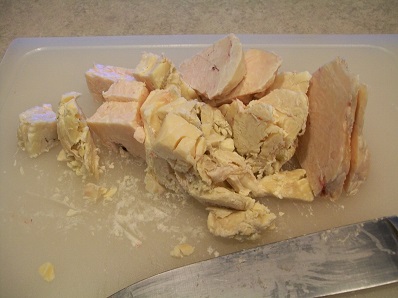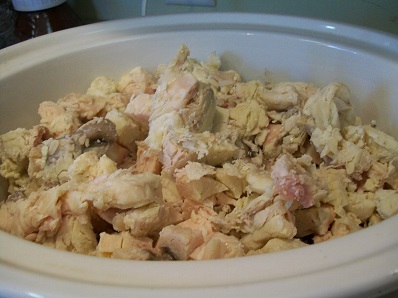This is something I remember watching my grandmother do in the Kitchen. She had a large pot and would slowly cook pig fat down until she had this almost clear liquid. She would then spoon the liquid into canning jars and I would watch in wonder as the liquid turned a pretty bright white. She would then use this in pie crusts and to fry foods.

lard being cut up
Using a crock-pot to render lard is a safer (you still need to be careful when you have hot oil and a heat source) and in my opinion , easier way to cook down beef or pig fat into a creamy white lard that makes pie crust taste wonderful.
I found a great deal on marked down pieces of beef fat at the grocery store. I picked up about 7 large pieces that total near 10lbs. I then took each pieces and cut them into smaller pieces (close to a cube as you can get) removing any larger pieces of raw meat I could. I put these smaller pieces into my 5 qt oval crock-pot and cooked them on low.

Lard cubes in crock-pot
It is important to do this when you have plenty of time. Check and stirring the lard is important. You want each piece to “melt” into a liquid that has a off yellow color to it (this is the liquid lard/oil). Every 30 minutes , I would stir the fat pieces until I had mostly liquid and smaller pieces of cracklins.
Once I had a good amount of liquid, I readied my canning jars and lids. Using a small screen strainer (you can see it in my pictures), I slowly ladled my liquid into my jars. The strainer kept the cracklins separate from my liquid gold.

finished product
As you fill the jars, wipe the rims and place your lids and rings on them. The hot liquid will help to seal the lid tightly on the jar. I store my jars in the freezer until I am ready to use the lard.

items I used
I took pictures as I went along, but I forgot to take a picture of the cracklins. I had maybe a quart jar of cracklins (smaller hard pieces that turn a darker color). You can eat these (we do not) . I put these in my “chicken bowl” and feed them as a snack to my flock.
Thank you for posting this recipe. I make my own suet cakes for the birds and sometimes have a hard time finding lard which is the main ingredient. This also may save me some money. Going to give it a try so I will always have it on hand.
Your’e welcome Peg!
Thank you for the great tip! I’ve tried rendering pork fat for lard in my cast iron dutch oven, but what a chore having to watch it constantly. Never occurred to me to use my crockpot. And pork cracklings are so tasty too – very low carb.
I’ve never rendered beef fat for suet though – the only thing I’d make with suet would be bird food, I guess. I don’t know if beef cracklings are even edible, though I do like the crunchy bits off a fresh grilled steak.
My CSA had a few pigs last year as an experiment/accident and pasture raised them. I got a big bag of fat (along with quite a bit of offal) and had been putting off rendering it till I saw your article. It’s cooking down now. I don’t have any really spoiled chickens so I’ll have to eat all of those darn cracklings myself.
Enjoy your cracklings Rick!
I ordered the fat from butcher( they didn’t have leaf) from a pig. Put in crockpot for like 9 hours yesterday from warm to low. It’s isn’t snowy white and I have yellow( almost jelly like) at bottom 🥺 Recommendations?
Hey Cait, if you lard is not snowy white when cooled and has a jelly like substance at the bottom (again when cooled) I would try rendering it again. Take the cooled lard and scrape off the jelly stuff (this is naturally occurring gelatin that is released when the fat cooks. You can discard this if you want. Then take the hardened fat and put it back in the slow cooker and melt it again on low heat being sure not to brown any bits and then strain it through some cheesecloth or another fine filter. Once cooled it should be whiter. You can do this process a few times if needed over a couple of days. Some types of pig fat contain more gelatin and other stuff that takes a while to cook out and remove.